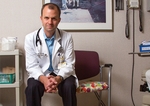Business
Wi-Fi "hot spots" created in some practices
■ With wireless fidelity, physicians are offering their patients the chance to surf the Internet while they wait.
By Mike Norbut — Posted Jan. 17, 2005
- WITH THIS STORY:
- » Related content
Instead of flipping through old magazines, patients at some Medical Clinic of North Texas offices can visit their favorite Web sites for updated news and market information.
Rather than sitting in the waiting room worried about what they're missing at work, patients at Georgia Reproductive Specialists can check their e-mail and send instant messages to co-workers as if they were down the hall.
Patients are doing this not through a community waiting-room computer, but through their own laptops and handheld devices. That's because these physician practices have created wireless fidelity "hot spots" in their offices.
Wi-Fi allows users on portable computers or devices to access the Internet without a physical modem connection. An access point enables a connection to a local area network and creates a hot spot for devices with wireless cards, which communicate with the network via radio signals.
With Wi-Fi becoming an affordable option for remote Internet access, some practices are extending the service to their patients as a way to improve customer service. It gives patients a chance to feel like they're accomplishing something while they wait, doctors said.
"The Internet is a necessary element in people's lives," said Khang Tran, MD, an internist in the West Plano office of the Medical Clinic of North Texas. "We don't like our patients to be waiting for a long time, but we want their wait to be as comfortable as possible."
The Medical Clinic of North Texas, which has 78 physicians in mostly primary care specialties, is spread across 24 sites. Six of the offices located in what the practice deems more technologically savvy areas around Dallas are now Wi-Fi hot spots.
Patients can access the Internet in the waiting room or even while sitting in the exam room, Dr. Tran said. The group already had the infrastructure in place -- including a high-speed Internet connection -- to support an electronic medical record system across all of its locations, so adding the wireless technology only cost a few hundred dollars per office, he said.
Regardless of a practice's technology infrastructure, setting up a Wi-Fi hot spot should not be that expensive, said Mark Perloe, MD, a reproductive endocrinologist and infertility specialist who serves as medical director of Georgia Reproductive Specialists.
"If they have Internet access, it should be fairly cheap," he said.
Dr. Perloe's group has three locations but has established a hot spot in its Atlanta office to accommodate the many patients working on laptop computers while in the waiting room.
Many patients at the practice already have made stops at different groups as they look to address their infertility issues. This might make them a little more stressed and pressed for time than patients at a typical family practice who might be waiting for an annual exam, Dr. Perloe said. "This is for those type-A personalities we have," he said. "We figured we could offer the opportunity for them to be on the Internet."
The group first set up the hot spot about a year ago, but it's not the type of service you see every patient using. Mainly that's because patients don't always think of bringing their laptops to the doctor's office the way they would to a coffee shop or bookstore, two types of commercial business that are creating Wi-Fi hot spots.
Dr. Perloe said the office has posted signs announcing the service and instructing patients how to access the network. The physicians also use Wi-Fi as a marketing tool, informing referring physicians of the service.
Dr. Tran said at his office, which has only offered wireless Internet access for a few months, the physicians have to remind patients of the service so, if they choose to use it, they will think ahead and bring their laptop to their next appointment.
"Those patients who use it, love it," he said. "There's just not enough people who know that we have it."












